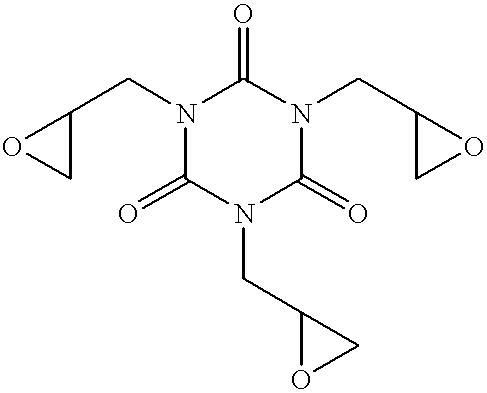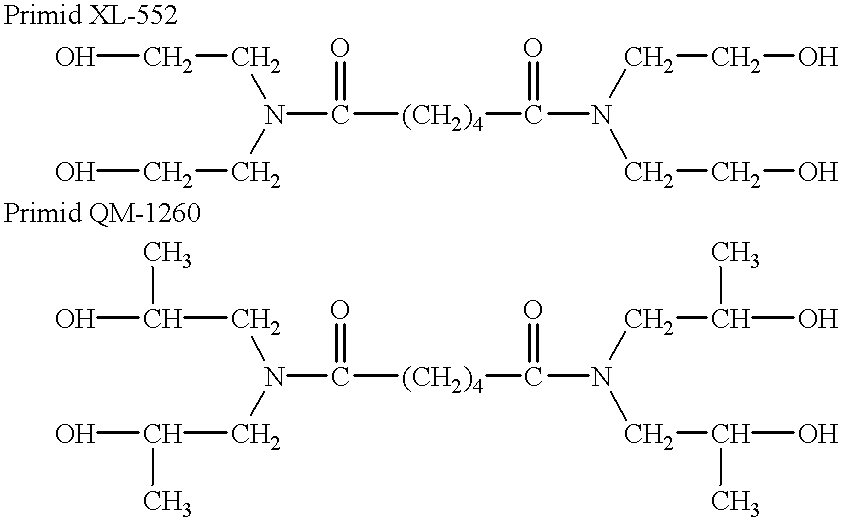Low temperature cure carboxyl terminated polyesters
a carboxyl terminated polyester, low temperature cure technology, applied in the direction of coatings, polyester coatings, etc., can solve the problems of volatile organic emissions resulting from coating compositions applied and used by industry and the consuming public, and the use of organic solvents in large quantities, so as to achieve the effect of maximum film properties such as hardness, flexibility, weatherability and gloss
- Summary
- Abstract
- Description
- Claims
- Application Information
AI Technical Summary
Benefits of technology
Problems solved by technology
Method used
Image
Examples
example 1
on of Carboxyl Terminated Polyesters
Stage 1
Preparation of Hydroxyl Terminated Oligomer
This mixture was heated to 240.degree. C. to an acid value of 7.5 with ICI plate and cone viscosity at 175.degree. C. of 4.8 poise. The hydroxyl number of this oligomer was found to be 70.
Stage 2
Preparation of Carboxylic Acid Terminated Polyester
The above oligomer was cooled to 180.degree. C. and added 179 gms of fumaric acid. The temperature was raised to 210-215.degree. C. and vacuum was applied slowly over a 30-minute period until a vacuum of 23-24 inches was obtained. The reaction was monitored by taking a sample and running the acid number and ICI cone and plate viscosity of 200.degree. C. After an acid value of 30-35 and ICI viscosity at 200.degree. C. of 13-20 poise were obtained, the melt was cooled down to 195.degree. C. and 8.0 gms of triphenyl ethyl phosphonium bromide catalyst was added and mixed into the resin for 20 minutes. After this period, the resin was discharged from the flask. ...
example 2
s of Carboxyl Terminated Polyesters
Following the procedure described in Example 1, compositions were prepared as indicated Table 1.
example 3
on of Powder Coatings
All polyesters were evaluated by the following method. 88.39 g of the granulated polyester resin was dry mixed with 6.65 g triglycidyl isocyanurate, 1.43 g Modaflow Powder III, 0.68 g Benzoin and 2.85 g carbon black (from Columbia Chemicals, Raven 22) and subsequently introduced into an extruder (Werner Pfleiderer, ZSK 30). The extrudate was cooled, ground and sieved. The sieved fraction smaller than 105 microns was collected and used as the powder coating. This powder coating was electrostatically sprayed onto steel panels. The physical properties of the formulated powder coating are determined after a 15-minute cure at 138.degree. F. for a 1.7 to 2.4 mils film thickness. The compositions and the test results of these powder coatings are given in Table 2.
TABLE 3
PUM
| Property | Measurement | Unit |
|---|---|---|
| Length | aaaaa | aaaaa |
| Percent by mass | aaaaa | aaaaa |
| Percent by mass | aaaaa | aaaaa |
Abstract
Description
Claims
Application Information
 Login to View More
Login to View More - R&D
- Intellectual Property
- Life Sciences
- Materials
- Tech Scout
- Unparalleled Data Quality
- Higher Quality Content
- 60% Fewer Hallucinations
Browse by: Latest US Patents, China's latest patents, Technical Efficacy Thesaurus, Application Domain, Technology Topic, Popular Technical Reports.
© 2025 PatSnap. All rights reserved.Legal|Privacy policy|Modern Slavery Act Transparency Statement|Sitemap|About US| Contact US: help@patsnap.com



